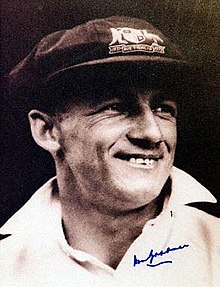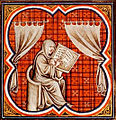Portal:Biography
The Biography Portal
A biography, or simply bio, is a detailed description of a person's life. It involves more than just basic facts like education, work, relationships, and death; it portrays a person's experience of these life events. Unlike a profile or curriculum vitae (résumé), a biography presents a subject's life story, highlighting various aspects of their life, including intimate details of experience, and may include an analysis of the subject's personality.
Biographical works are usually non-fiction, but fiction can also be used to portray a person's life. One in-depth form of biographical coverage is called legacy writing. Works in diverse media, from literature to film, form the genre known as biography.
An authorized biography is written with the permission, cooperation, and at times, participation of a subject or a subject's heirs. An autobiography is written by the person themselves, sometimes with the assistance of a collaborator or ghostwriter. (Full article...)
Featured biographies –
Momčilo Đujić (Serbo-Croatian Cyrillic: Момчилo Ђујић, pronounced [mǒmtʃiːlo dʑûːjitɕ]; 27 February 1907 – 11 September 1999) was a Serbian Orthodox priest and Chetnik vojvoda. He led a significant proportion of the Chetniks within the northern Dalmatia and western Bosnia regions of the Independent State of Croatia (NDH), a fascist puppet state created from parts of the occupied Kingdom of Yugoslavia during World War II. In this role he collaborated extensively with the Italian and then the German occupying forces against the communist-led Partisan insurgency.
Đujić was ordained as a priest in 1933 and gained a reputation as something of a firebrand in the pulpit. After the assassination of King Alexander of Yugoslavia in 1934, he joined the Chetnik Association of Kosta Pećanac, forming several bands in the Knin region of Dalmatia. The Chetnik Association became a reactionary force used by the central government to oppress the populace. Active in promoting workers' rights, Đujić was briefly jailed for leading a protest by railroad workers, and he was a member of the exclusively-Serb Agrarian Union political party. (Full article...)

Sir Donald George Bradman AC (27 August 1908 – 25 February 2001), nicknamed "The Don", was an Australian international cricketer, widely acknowledged as the greatest batsman of all time. His cricketing successes have been claimed by Shane Warne, among others, to make Bradman the "greatest sportsperson" in history. Bradman's career Test batting average of 99.94 is considered by some to be the greatest achievement by any sportsman in any major sport.
Although Bradman reportedly disliked fame, his iconic status made him one of Australia's best-known personalities and arguably the country's "first celebrity". (Full article...)
Brigadier Arthur Seaforth Blackburn, VC, CMG, CBE, ED, JP (25 November 1892 – 24 November 1960) was an Australian soldier, lawyer, politician, and recipient of the Victoria Cross (VC), the highest award for valour in battle that could be awarded to a member of the Australian armed forces at the time. A lawyer and part-time soldier prior to the outbreak of World War I, Blackburn enlisted in the Australian Imperial Force in August 1914, and was assigned to the 10th Battalion. His unit landed at Anzac Cove, Gallipoli, on April 25, 1915, and he and another scout were credited with advancing the furthest inland on the day of the landing. Blackburn was later commissioned and, along with his battalion, spent the rest of the Gallipoli campaign fighting Ottoman forces.
The 10th Battalion was withdrawn from Gallipoli in November 1915, and after re-organising and training in Egypt, sailed for the Western Front in late March 1916. It saw its first real fighting in France on 23 July during the Battle of Pozières, part of the Battle of the Somme. It was during this battle that Blackburn's actions resulted in a recommendation for his award of the VC. Commanding 50 men, he led four separate sorties to drive the Germans from a strong point using hand grenades, capturing 370 yards (340 m) of trench. He was the first member of his battalion to be awarded the VC during World War I, and the first South Australian to receive the VC. He also fought in the Battle of Mouquet Farm in August, before being evacuated to the United Kingdom and then Australia suffering from illness. He was medically discharged in early 1917. (Full article...)
Nikolai Alexandrovich Kulikovsky (5 November 1881 – 11 August 1958) was the second husband of Grand Duchess Olga Alexandrovna of Russia, the sister of Tsar Nicholas II and daughter of Tsar Alexander III.
He was born into a military landowning family from the south of the Russian Empire, and followed the family tradition by entering the army. In 1903, he was noticed by Grand Duchess Olga during a military review, and they became close friends. Olga wanted to divorce her first husband, Duke Peter Alexandrovich of Oldenburg, and marry Kulikovsky, but neither her husband nor her brother, the Tsar, would allow it. (Full article...)
Robert Mann (April 8, 1924 – October 21, 2006) was an American professional football player in the National Football League (NFL). A native of New Bern, North Carolina, Mann played college football for the Hampton Pirates in 1942 and 1943 and the Michigan Wolverines in 1944, 1946 and 1947. Playing the end position, he broke the Big Ten Conference record for receiving yards in 1946 and 1947. After not being selected in the 1948 NFL draft, Mann signed his first professional football contract with the Detroit Lions, where he stayed for two seasons. He later played for the Green Bay Packers for parts of five seasons until 1954. Mann broke the color barrier for both teams.
Mann led the NFL in receiving yards with 1,014 in the 1949 season. He was asked to take a pay cut after the season and became a holdout when the Lions opened practice in July 1950. He was traded to the New York Yanks in August 1950 and released three weeks later. Mann charged that he had been forced out of professional football for refusing to take a pay cut. He signed with the Green Bay Packers near the end of the 1950 NFL season and was the team's leading receiver in 1951. He remained with the Packers through part of the 1954 season. After his football career, Mann became a lawyer and practiced in Detroit. He was inducted into the Green Bay Packers Hall of Fame in 1988 and died on October 21, 2006, at the age of 82. He was posthumously inducted into the Michigan Sports Hall of Fame in 2016. (Full article...)
On the night of 5 April 1944, Siegfried Lederer, a Czech Jew, escaped from the Auschwitz concentration camp wearing an SS-TV uniform provided by SS-Rottenführer Viktor Pestek. Pestek opposed the Holocaust; he was a devout Catholic and was infatuated with Renée Neumann, a Jewish prisoner. Pestek accompanied Lederer out of the camp, and the two men traveled together to the Protectorate of Bohemia and Moravia to obtain false documents for Neumann and her mother.
Lederer, a former Czechoslovak Army officer and member of the Czech resistance, tried unsuccessfully to warn the Jews at Theresienstadt Ghetto about the mass murders at Auschwitz. He and Pestek returned to Auschwitz in an attempt to rescue Neumann and her mother. Pestek was arrested under disputed circumstances and later executed. Lederer returned to occupied Czechoslovakia, where he rejoined the resistance movement and attempted to smuggle a report on Auschwitz to the International Committee of the Red Cross in Switzerland. After the war he remained in Czechoslovakia. The story of the escape was retold by Lederer and writers including historian Erich Kulka. (Full article...)
Nash quickly became engaged in revolutionary activities, and served as a delegate to the first three Patriot provincial congresses. In 1775, he was named lieutenant colonel of the 1st North Carolina Regiment under Colonel James Moore, and served briefly in the southern theater of the Revolutionary War before being ordered north. Nash was made a brigadier general in 1777 upon Moore's death, and given command of the North Carolina brigade of the Continental Army under General George Washington. He led North Carolina's soldiers in the Philadelphia campaign, but was wounded at the Battle of Germantown on October 4, 1777, and died several days later. Nash was one of ten Patriot generals to die from wounds received in combat between 1775 and 1781. He is honored by several city and county names, including those of Nashville, Tennessee; Nashville, North Carolina; and Nash County, North Carolina. (Full article...)
Martin Rundkvist (born 4 April 1972) is a Swedish archaeologist and associate professor at the University of Łódź in Poland. His research focuses on the Bronze, Iron, and Middle Ages of Scandinavia, including significant excavations in the province of Östergötland.
Rundkvist has studied and excavated various sites in Sweden, particularly in the country's south. In 2003 and 2004, he published a three-volume work which doubled as his PhD dissertation, cataloguing the finds from Barshalder, the largest prehistoric cemetery on the Swedish island of Gotland. A subsequent book identified nine possible regional power centres in Östergötland, and attempted to determine where the "Beowulfian mead halls" of the day once stood. Excavating years later at one of these sites, Aska, Rundkvist uncovered the foundations of a large mead hall, and 30 ornate gold figures that might have represented gods or royals. In other works, Rundkvist has excavated a Viking boat grave, and analysed both the placement of deposited artefacts in the landscape and the lifestyles of the Scandinavian élite during the Middle Ages. (Full article...)















































